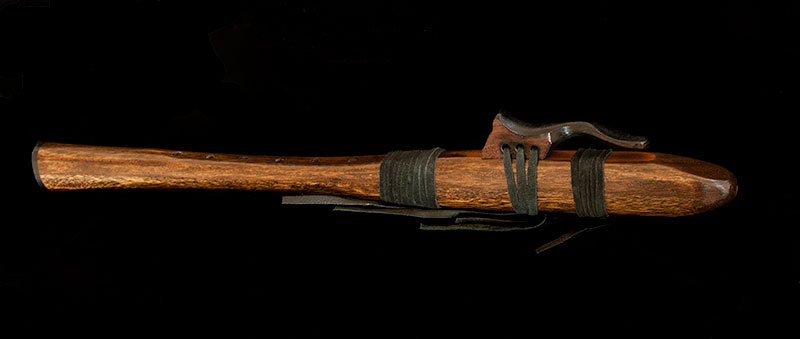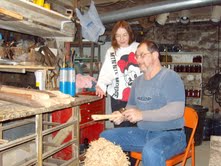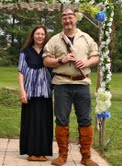| |
Historic Points
Pre-Columbian to modern times |
Mississippian
Points
400 B.P. to 1300 B.P. |
Woodland Points
1300 B.P. to 3,000 B.P. |
Late Archaic Points
3,000 B.P. to 5,000 B.P. |
Mid Archaic
Points
5,000 to 6,500 B.P. |
Early
Archaic Points
6,500 to 9,000 B.P. |
Paleo Points
9,000 B.P. to 11,500 B.P. |
|
Stone Tools - Celts, Net weights, Axes, Banner Stones |
|
Dalton's |
Pendants & Gorgets |
|
Ex-Stagecoach
Lane Collection |
Ex-Stangland
Collection |
Ex-Lillian
Martel Collection |
Point Notes |
| |
|
Musical Instruments |

Musical
Instruments
Native American Plains
Style Walnut Flute
|

|
From the artist Randy
Bryhn: "Made from stained Walnut, the dark color has made this type of
wood sacred to most Native American clans that knew of it. It's dark color
seemed to hint of mystery, and as a result was a favorite wood to be used by
the medicine man of the clan. The finger-hole area is etched and
darkened, while the Byrd has a wing type design for use outside in a breeze.
This flute is a full size man’s flute, and measures approximately 23 inches
in length. This is a flute with an excellent voice that would be good for
both inside and outside playing. The profile of this flute shows a long
slender body that is excellent to play on. Walnut is a very close grained
wood that has performed for me well in the past, and seems to play well even
on very humid days. I held off etching, and decorating this one
because the wood grain was so pronounced. The voice is really nice, and is
very stable in the bottom finger hole. The end of the flute is squared off,
and blunt, as an alternative to the tapered design I usually put on my
flutes. The Flute Fundamental Note is: SHARP “F”.
The flutes I make are
considered very rare. Not only is the plains tuner one of the original
designs, and not used very much today, but the flute actually was hand
whittled. In today's world anything made by hand is hard to find, and
through my own researches I only know of one other mainstream flute maker
who hand whittles his flutes. However, he also has also gone on to use a
lathe in his creations, so it is quite possible that I am the last.
Currently I am celebrating the making of my one thousandth flute, after
eleven years of selling flutes here, and at gatherings. I hope you like the
flute."


More from Randy Bryhn: Normally, EVERY
Native American brave, no matter what tribe had to make a flute. In some cases
it was made by the brave’s father, and presented to him upon becoming a man, and
sometimes if the brave could afford it, he would purchase one. It should be
noted though that a flute in those days was worth a horse that had been broken
for riding, in other words very costly. Before the advent of the tuner though,
flutes were very hard to play. The whole ceremony was the making of the flute,
since without a tuner they are extremely hard to play. The brave would take
sometimes as much as a month to produce the flute, and by that time everyone in
the camp would know his intentions, especially the girl’s father. The brave
would then go to the father and ask permission to ask for her hand. If agreeable
the father would give the brave some splinters, they were what had been called
matches in those days. That night the brave would come to the girl, and hold the
burning matches near her. If she wanted him then she would blow out the matches,
if not he had to leave the dwelling…that’s when things get rough. The whole idea
in the beginning was to NOT play the flute, because it wasn’t user friendly back
in the early days. The next day as the girls would exit the dwelling the brave
would be playing the flute, and when he saw his beloved his would alter the
tempo of his song. This to show her that she was indeed the girl he longed for.
I have one of the early flutes made in this fashion and even after many years of
trying I can only make it squawk a few broken notes. After the wedding ceremony
was complete the brave would then bury the flute, (probably in disgust), but
with the introduction of the tuner things changed and the flute became a prized
possession that was kept by the brave. In those days it was considered a man’s
item, and the women were not allowed to touch it, ever.
When I discussed making a flute for my wife with my mentor, he was at first
upset with me. “This is a mans item,” he said to me. Yet when I asked him who
most of his customers were, he agreed that most of them were women. Now he is
not angry with me any more, and I have noticed some of his flutes have gotten
noticeably shorter…though he won’t tell me why.

Randy's E-store

|

|
Pow Wow Drum
Purchased at Alta Loma Pow
Wow, June 8, 2013
Buffalo Hide on cedar, 18" x 10"
Didn't think to get more
details at the time

|

| |
Catherine's Autoharps
Info Coming |
| |
|
Useful
Resources
|
|
|

Authentic
Artifact
Collectors
Association
______
Overstreetid.com
The Official Overstreet Indian
Arrowhead Identification Online Database
______
|
|
|
|
|
|
|